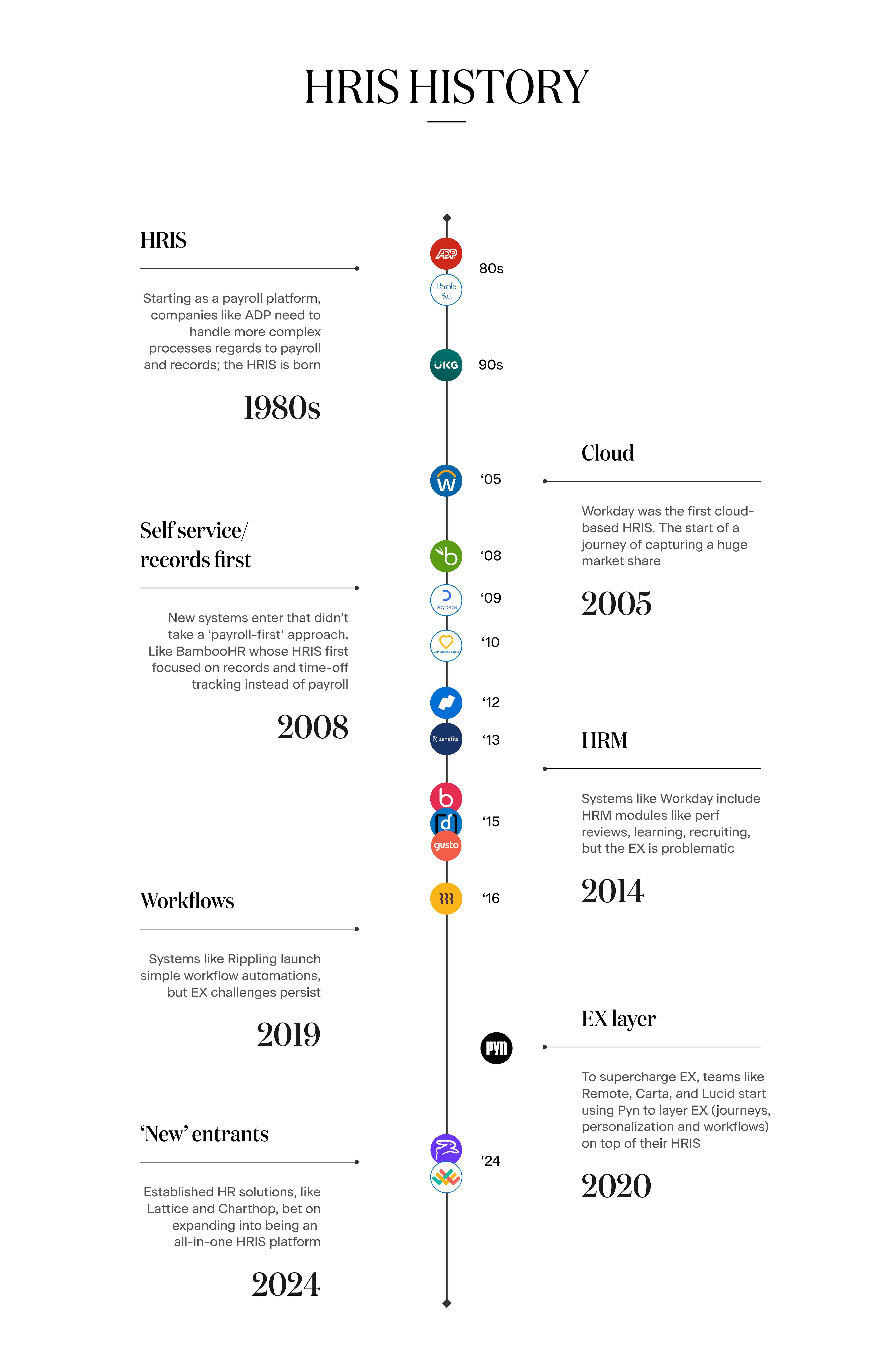
History of the HRIS: how it fails at Employee Experience
Why do employees, business leaders, and HR professionals complain so much about their HRIS? And, where does this leave companies who really care about EX?

Written by
Joris Luijke, Co-Founder & Co-CEO
In May 2024, a Business Insider article highlighted the challenges (read: frustrations) with Workday in delivering Employee Experience (EX): “every HR professional and hiring manager — whose lives are supposedly made easier by Workday — described the system with a sense of cosmic exasperation.” Their research didn’t just single out Workday; it noted that HRIS competitors receive similar complaints.
So, why do employees, business leaders, and HR professionals complain so much about their HRIS? And, where does this leave companies who really care about EX?
I decided to dig a little deeper.
For what it’s worth, I’ve used plenty of these systems throughout my HR career, including Workday, Namely, UKG, BambooHR, and SuccessFactors (back when they only focused on performance).
The History and Purpose of HRIS
In the 80s, systems like ADP and PeopleSoft introduced the HRIS to better manage complex HR tasks related to payroll and employee records. They were designed for HR (and finance), not for employees.
Over time, HRIS platforms added HRM modules, like performance management and recruiting. Or, HCM point-solutions added HRIS functionality, like SuccessFactors. Employees continued complaining that these bolted-on modules felt bureaucratic and unfriendly.
Business Insider points out that, although HRIS platforms are “meant to make things faster, simpler for workers, their focus is mostly on providing the value of a one-stop HR shop to their paying customers,” which is HR. “Customer service is Workday's goal – It's just that the customer isn't the employee.”

HRIS systems would need to be completely rebuilt, a mammoth task that would take many years. I don’t think it’s likely to happen unless the vendors start losing serious revenue.
Inability to (re)design for the employee
I’m not saying these systems don’t have important capabilities; I just recognize they fail to deliver a positive employee experience:
- Employee Experience overlooked: Designed for HR administrators, not employees, resulting in clunky interfaces and non-intuitive navigation.
- One-size-fits-all approach: Standardized systems fail to cater to diverse employee needs, lacking personalization and timeliness.
- Reactive rather than proactive: Traditional systems manage issues as they arise instead of anticipating and addressing employee needs proactively.
- Integration issues: Poor integration with other workplace tech creates disjointed experiences.
What employees need
Unless HRIS systems change overnight (they won’t), companies will need to find ways to layer EX on top of their HRIS to transform static, data-focused HRIS into dynamic, employee-centric experience.
- Employee-centric design: Create intuitive and user-friendly systems integrated into the flow of work. Understand and design with the employee journey in mind.
- Personalization: Only notify someone when it’s really relevant to them. Offer features tailored to individual needs.
- Proactive: Deterministic systems and AI to predict and address employee needs, transforming the experience from good to exceptional.
- Seamless: Ensure HR systems integrate with or leverage other technologies for a cohesive ecosystem.
Where does this leave companies who really care about EX?
Companies who care about creating a great employee experience are left with a few options:
- Wait: HRIS vendors may, over time, make improvements. Or new HRIS solutions may enter the market (likely supporting smaller business <1000 employees first). Honestly, I waited a long time and heard many promises - I couldn’t wait any longer. 😅
- Assemble: you can use a bunch of best in breed tools and try to make it all work together. In the past, I tried Zapier, custom code, and several solutions to assemble what, I thought, was a pretty decent EX. Over the years, I spoke to many peers who tried similar things.
- Layer on EX: To supercharge EX, teams like Remote, Carta, and Lucid start using Pyn to layer EX ( employee journeys, personalization and workflows) on top of their HRIS.
Feel free to share your thoughts and experiences. How has your organization tackled the challenges of HRIS in enhancing employee experience?

Joris dreamt of having Pyn as Head of People at Atlassian and Squarespace. Now dreams of getting a sleep-in on Sunday.
